
Cooyar War Memorial is a heritage-listed war memorial in Hack Menkins Park, McDougall Street, Cooyar, Toowoomba Region, Queensland, Australia. The memorial was unveiled on Saturday 14 July 1923 by Arthur Edward Moore. It was designed and produced by R. C. Ziegler and Son and cost £413/10/0, with funds raised by public subscriptions and revenue raised from entertainments. The memorial comprises two pieces, the pedestal surmounted by a digger statue, on which the names of the 25 fallen are recorded, and a smaller plinth which records the names of the 110 local men who served in World War I. It was added to the Queensland Heritage Register on 21 October 1992.

Boer War Memorial is a heritage-listed war memorial at Crescent Street, Gatton, Queensland, Australia. It was designed by William Hodgen and produced by Toowoomba mason William Bruce. It was built in 1908, and was unveiled on 3 August by Governor of Queensland, Lord Chelmsford. The memorial honours four local men who died in or as a result of the war, and is one of only three known Boer War memorials in Queensland. It is also known as the Fallen Soldiers Memorial and the South African War Memorial.
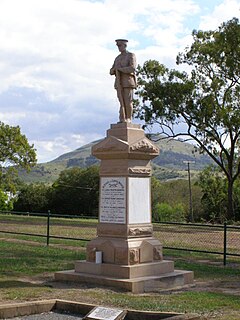
Ma Ma Creek War Memorial is a heritage-listed memorial on the Gatton-Clifton Road, Ma Ma Creek, Queensland, Australia. It was completed in 1920. It was added to the Queensland Heritage Register on 21 October 1992.

Beaudesert War Memorial is a heritage-listed memorial at William Street, Beaudesert, Queensland, Australia. It was built from 1919 to 1921. It was added to the Queensland Heritage Register on 21 October 1992.
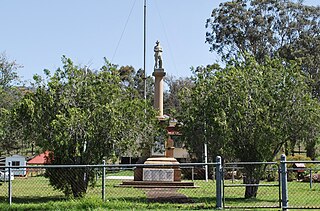
Maroon War Memorial & Memorial Enclosure is a heritage-listed memorial at Boonah - Rathdowney Road, Maroon, Scenic Rim Region, Queensland, Australia. It was designed and built in 1920 by Frank Williams and Co. It was added to the Queensland Heritage Register on 21 October 1992.
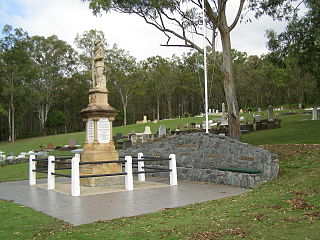
Pimpama & Ormeau War Memorial is a heritage-listed memorial at Pacific Highway, Pimpama, Queensland, Australia. It was built in 1919. It was added to the Queensland Heritage Register on 21 October 1992.
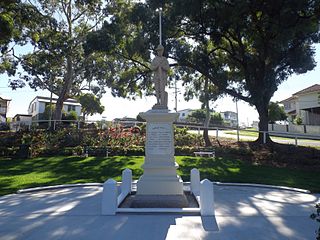
Manly War Memorial is a heritage-listed memorial at 184 Carlton Terrace, Manly, City of Brisbane, Queensland, Australia. It was built from 1920 to 1921. It is also known as Ferguson Street Reserve, Manly Dam, and Soldiers Memorial Park. It was added to the Queensland Heritage Register on 21 August 1992.

Oxley War Memorial is a heritage-listed memorial at 1218 Oxley Road, Oxley, Queensland, Australia. It was built in 1920. It is also known as Oxley Memorial Park and Oxley Place. It was added to the Queensland Heritage Register on 4 July 2006.
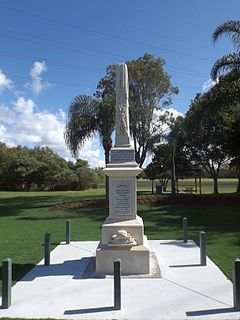
Anning Monument is a heritage-listed memorial at the corner of Hemmant and Tingalpa Road and Boonoo Street, Hemmant, City of Brisbane, Queensland, Australia. It was designed and built by William Busby in 1903. It is also known as Hemmant Boer War Memorial. It was added to the Queensland Heritage Register on 21 October 1992.

Booval War Memorial is a heritage-listed memorial at Green Street, Booval, City of Ipswich, Queensland, Australia. It was built in 1919. It was added to the Queensland Heritage Register on 21 October 1992.

Brooweena War Memorial is a heritage-listed memorial at Smith Crescent, Brooweena, Fraser Coast Region, Queensland, Australia. It was built in 1922 by F W Webb. It was added to the Queensland Heritage Register on 21 October 1992.

Howard War Memorial is a heritage-listed memorial at William Street, Howard, Fraser Coast Region, Queensland, Australia. It was built in 1921. It was added to the Queensland Heritage Register on 21 October 1992.

Apple Tree Creek War Memorial is a heritage-listed memorial at Bruce Highway, Apple Tree Creek, Bundaberg Region, Queensland, Australia. It was designed and built in 1921 by Andrew Lang Petrie. It was added to the Queensland Heritage Register on 21 October 1992.

Finch Hatton War Memorial is a heritage-listed memorial at Anzac Parade, Finch Hatton, Mackay Region, Queensland, Australia. It was designed by Melrose & Fenwick and built in 1921 by Melrose & Fenwick. It was added to the Queensland Heritage Register on 21 October 1992.

World War I Cenotaph is a heritage-listed memorial at Jubliee Park, Alfred Street, Mackay, Mackay Region, Queensland, Australia. It was designed by Stephen Harvey and built from 1928 to 1929 by Melrose & Fenwick. It is also known as Mackay War Memorial and Jubilee Park. It was added to the Queensland Heritage Register on 21 August 1992.

Melrose & Fenwick were a monumental masonry firm in Townsville, Queensland, Australia. They are known for the many Queensland war memorials that they produced.

FDA Carstens Memorial is a heritage-listed memorial at Macrossan Street, Port Douglas, Shire of Douglas, Queensland, Australia. It was built from 1907 to 1908 by Melrose & Fenwick (Townsville). It was added to the Queensland Heritage Register on 9 September 2003.
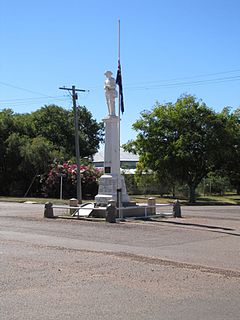
Aramac War Memorial is a heritage-listed memorial at Lodge Street, Aramac, Barcaldine Region, Queensland, Australia. It was designed and built by F M Allan in 1924. It was added to the Queensland Heritage Register on 21 October 1992.

Cairns War Memorial is a heritage-listed memorial at The Esplanade, Cairns, Cairns Region, Queensland, Australia. It was built in 1925. It was added to the Queensland Heritage Register on 21 October 1992.

Dalby War Memorial and Gates is a heritage-listed memorial at Patrick Street, Dalby, Western Downs Region, Queensland, Australia. It was designed and built in 1922 by Harry Shill and British firms. It was added to the Queensland Heritage Register on 21 October 1992.



























